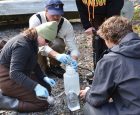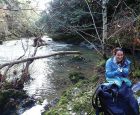
Features
Research
Using scent to help Chinook salmon find their way
In an effort to find ways to prevent hatchery fish from straying, Oregon State University researcher Maryam Kamran has been working with the Oregon Hatchery Research Center to study salmon responses to various scent stimuli. In recent years, Chinook salmon (Oncorhynchus tshawytscha) in the area are not homing as well as they once were, Kamran says.
March 12, 2019 By Matt Jones
 Oregon State University researcher Maryam Kamran is leading a research effort to find scents that could be used to help salmon find their way back home to their native tributaries. She hopes the research will provide a template for similar efforts in other jurisdictions. In an effort to find ways to prevent hatchery fish from straying
Oregon State University researcher Maryam Kamran is leading a research effort to find scents that could be used to help salmon find their way back home to their native tributaries. She hopes the research will provide a template for similar efforts in other jurisdictions. In an effort to find ways to prevent hatchery fish from straying“With salmon homing, they go out to the ocean and they come back after a few years and they come back to their natal tributary – where they were born and that’s where they mate,” says Kamran. “They only get one chance to do this and so they have to get it right. Research has shown that more and more fish weren’t coming back to the areas that they were supposed to.”
When returning home, the scent of the natal tributary is very important in the homing process.
Technically known as olfactory imprinting, familiar scents can act as a landmark to help guide the salmon, which Kamran compares to billboards or road signs. Her research project focused specifically on the Elk River Hatchery, which has had significant problems with straying in the past.
Kamran and her collaborators have been testing artificial odors which could be used at the hatchery to give a distinct odor which the fish will recognize – one which would be safe for release into the water, cost effective, able to persist in the environment, and can be detected by a salmon’s nose. An important distinction, she notes, is that the odor must not be an attractive or aversive odor. The goal is to find an odor which does not induce a behavioral response – which could impact other species – but rather one that can simply be detected. They are also testing to find the best timing for the use of effective imprinting.
“Primarily, the most robust response we saw were with a combination of amino acids,” says Kamran.
The information gathering and testing phases of the research are nearly complete. Their research is specific to the conditions in the Elk River, however, Kamran hopes their model could be used as a template for similar research projects in other areas.
“It will be specific to what’s already in the water there in terms of the chemical cues available, the species, the run timings – all these different things will have to be factored in.”
Print this page
Advertisement
- Industry optimism high at latest international aquaculture conference
- More income for brackish-water farming in Malaysia: study









